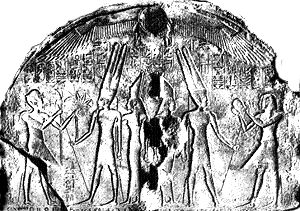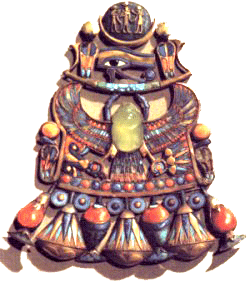|
|
|
by Andy Lloyd August 2000 from DarkStar1 Website
Let us look more closely at the ancient Egyptian mythology relevant to the Dark Star Theory, and explore the mythology central to an understanding of that sacred part of the sky, the Duat.
In doing so, it will become clear why
I have proposed that this sacred area of the sky dominated by Sirius and
Orion marks the perihelion passage of
Nibiru.
We have already looked at the idea that Horus, born of Isis, represented Nibiru, born in the sky near Sirius during the time of its heliacal setting and rising (DS6). But what of the other major figure in this mythological drama, the evil god Seth?
There is some evidence that he was associated with the planet Mercury.
He is clearly identified in ancient Egyptian mythology as a dark or invisible serpent, as well as a red-haired man:
None of the above rules out a connection between Seth and Mercury, but the mythological identity of Seth as an invisible, red 'star' akin to a serpent seems more in keeping with what we know about Nibiru. The other difficulty with the idea that Seth was associated with Mercury is the solar aspect identified with his worship.
Whilst discussing the magical rituals of the Egyptians, Seligmann described this gruesome ceremony aimed at Seth:
Here we have a solar god revered for its might and dominance, yet described as invisible.
Mercury lies close to the Sun, and one could argue that this religious outburst may have been aimed at the 'invisible' Mercury of day-time. But why worship Mercury in the day? Why not carry out the ceremony at dusk or dawn, when Mercury appears as an evening or morning star?
Not only that, but the concept of terrible destructive power associated with Seth seems at odds with Mercury’s low celestial profile. This presents us with a quandary, and opens up the possibility that Seth has been associated with the wrong planet. A more powerful identity is called for. It is not Venus, the other planet that is associated with the Sun.
Could this imagery
again be alluding to an invisible solar deity which is, at times, hidden
behind the Sun?
They represent a duality of good and evil, and the
myths surrounding them attempt to explain the bizarre nature of the Dark
Star; sometimes fiery, mostly invisible. In this way, Nibiru was also
understood as both a force for good - the heavenly domain of the gods - but
also represented great potential evil, whose arrival in the heavens could
signal coming apocalyptic destruction.
This fits the notion that Seth represents our brown dwarf in cometary motion; a dark star with red appearance and halo, which challenges the Sun with its opposite motion in the heavens. The dark star is associated with evil-doing and the death of gods, in keeping with the cataclysmic role of Nibiru in the Enuma Elish.
One would expect the myths
surrounding Nibiru’s appearance to reflect this mix of terror and hopeful
expectation in the human populations of the prehistoric world.
The following poetic rendering of the appearance of Horus nudges us in the direction of a celestial object appearing miraculously from the depths of space:
Yet Horus is not itself identified with our Sun, as many Egyptologists claim, but is both a stellar and solar son of Isis, who is represented by Sirius.
The Egyptologists have once again reduced everything down to the Sun, which is their standard way of analyzing ancient Egyptian mythology. Yet, if the Egyptians were describing two ‘Suns’, one the life-giver, Ra; the other a dark, hidden ‘sun', Horus, then the myths begin to become more clear.
Horus can be identified as a ‘sun’ that is born out of Sirius, appearing periodically from the primordial deep. Its appearance is momentous, marking the passing of an era.
Horus In the Island of Fire
The myth is describing the Flood, occurring simultaneously with the disappearance of the sun god into the primordial darkness. The cataclysmic consequences of the sun-god's journey go beyond the familiar assertion that these myths describe the annual flooding of the Nile.
The discussion is more Biblical in content. The sun god becomes invisible in the heavens, decreasing in size to a ‘small snake’, and finally ‘invisible to the gods’. This seems to denote Nibiru’s exit from the Solar System at the end of the catastrophic perihelion passage that flooded the world.
Horus' depiction of
being set in the 'island of fire' is reminiscent of that other Egyptian
myth, the Phoenix, which is also identifiable with the Dark Star.
He enters the domain of Osiris, the divine judge of the dead, in the 7th hour, and finally emerges at dawn, the 12th hour division, entering the ‘tail of the mighty serpent, which is named 'Divine Life’. This final gate is guarded by Isis and Nepthys, and signifies the Sun rising at dawn with Sirius (Isis).
But there is a problem of scale
with this interpretation: Sirius and Orion are practically adjacent to one
another in the heavens. So if the Duat were describing the celestial journey
of the Solar Disc through the constellations under the horizon at night,
then they should be adjacent segments, certainly not the 7th and the 12th.
Each section represented one ten-day interval, or Egyptian week. As E.C Krupp describes:
Of particular interest was the heliacal rising of Sirius, the decan associated with the Summer Solstice during the Pyramid Age.
This shortest night is about 6 modern hours long in Egypt. The night-time was divided into 12 intervals, which represented the fact that only 12 of the possible 36 decans could be seen that night. So at this crucial time of year, when the Duat was ‘activated’, the Egyptian nocturnal variable hour was only ½ modern hour long.
The Duat, according to this way of thinking, comprised one third of the total Solar Cycle in the sky, rather than one half. In contrast, some Egyptologists consider the Duat to be active all year-long. But the star clock hypothesis goes some way to explaining the anomalous number of divisions between Sirius and Orion in the Duat. Saying that, it is still difficult to understand why as many as 6 intervals should exist between adjacent star constellations.
There are more difficulties with the
conventional understanding of the Duat.
A
more precise method surely would have involved choosing stars in the zodiac
to be decans. There are perfectly adequate stars on the ecliptic near
Sirius and Orion in the form of Pollux, Castor and Alhena in Gemini; and Aldebaran
and the Hyades in Taurus!
But there is a more important point here; the Isis/Osiris/Horus mythology predated the Pyramid Age considerably, and represented the most ancient of Egyptian mythology. As one goes back in time, then the precession of the equinoxes take the heliacal rising of Sirius further away from the solstice, occurring earlier in the year as you go back further in time.
Therefore, the more ancient source of this
mythology cannot have arisen based upon the Nile flood timing, or indeed the
Summer Solstice, because these religious notions pre-date this calendrical
coincidence
The Duat mythology involves the barque of Ra traveling through the various decans and encountering the monsters and deities associated with each. Which begs the question: How can Ra, as the invisible serpent, encounter the God of the Dead, Osiris, if the Sun doesn't actually pass through Orion?
This is a fundamental problem with the Egyptology position, and casts their interpretation of the nature of the Duat into doubt. To encounter Osiris, our celestial traveler must pass through Orion, and therefore travel off the ecliptic. Up until now, that point has been unanswerable, as all the visible planets travel along the ecliptic. But Babylonian texts indicate that an entirely different body passed through Canis Major and Orion in the form of Marduk, or Nibiru.
My
contention is that Sirius marks the perihelion position of the Dark Star,
and that the choice of decans south of the ecliptic indicates the Winged
Disc’s appearance in the Duat.
The conventional dawn divisions fit neatly with the initial appearance of Nibiru as it approaches Sirius in its opposing trajectory to the Sun:
This point of rebirth of the Dark Star near Sirius also marks the beginning of the cycle of the Duat, and the fiery sun-god is Horus, returning to the skies after its era-long absence.
It overcomes a high wall, which signifies Nibiru’s swing around the Sun and change of celestial direction, and enters the gate of the Duat in the 1st division. The red star Horus battles with the great serpent Apep from that point on, as it moves on through the next few divisions, signifying how the bright red orb could again be made invisible by the Serpent Seth at any time. But it fights through a mass of flying monsters to pass near the Drowning Pool (signifying the point where the Flood was unleashed on the Earth in a previous Nibiruan passage), and then enters Orion in the 7th division.
At this point of the Duat, the souls
of the dead are judged by Osiris and a great fight ensues with the serpent,
showing how Seth, the invisible black snake, begins to overcome
Horus and
establish himself as the sun-god identity. In the 10th division onward the
monsters that the sun god encounters take on a more watery character,
showing how it has again become submerged in the primordial deep, and fully
taken on the guise of Seth.
It appears faintly near Cancer, and brightens significantly as it moves towards Sirius. This rebirth by Sirius (Isis) denotes its character as Horus, and shows Horus’s victory over the evil darkness of the Seth identity. The perihelion marks the point of rebirth, the movement past the high wall (around the Sun) and thus through the ‘gate of the Duat’.
This is the end of the 12th division and the start of the 1st. On towards Orion it goes, fading as it does so. (The memories of the Flood are captured by the monuments of Giza, and their age-long vigilance, denoting the celestial point of Nibiru's journey through Orion when the world was once destroyed by the sun god). From there, the red orb fades rapidly as it swings towards Taurus and Aries. Finally it is lost to the darkness, and becomes the dark serpent, Seth, once again.
Like a
serpent biting its tail, the invisible path of the dark star eventually
leads back to Isis, creating an Ouroboros in the sky.
The problem has been the previous lack of another ‘sun’ to pin one of them on. Naturally enough, everything has been reduced to the one Sun. The cult of Ra arose after the Osiris/Isis/Horus cult. Egyptian religion was a conglomeration of different pantheons of deities, many of them imported, and the Egyptians were loath to discard any of the ‘old gods’ in favor of the new.
As such, their mythology grew by molding one god onto another, and this is what eventually happened with the Horus sun god:
This point is crucial. Horus was
depicted by the ancient Egyptians in the
same way that Nibiru was depicted by the Sumerians. Given that the Sumerian
culture pre-dated Dynastic Egypt, and that the Egyptians were fond of
importing foreign religious ideas, it is evident that the appearance of the
Winged Planet was worshipped by the Egyptians as Horus.
The Sun cult absorbed the star cult during and after the Fourth Dynasty, in the same way that Christianity was so adept at absorbing the polytheistic religions it replaced, forming a pantheon of saints to make up for the lost gods. In the Egyptological text dealing with this absorption of the Horus identity into the Ra identity, it is clear that they were not one-and-the-same, but rather two separate solar identities:
Here is clear proof that the Horus identity was that of Nibiru, and became a second sun in the sky on the rare occasions of the Winged Planet’s perihelion passage. The slaying of the enemies denotes the defeat of those who had ceased to believe in the celestial home-world of the gods. Horus had a number of different names, depending upon the time-frame and Egyptian sect worshipping him.
This creates difficulties of interpretation for Egyptologists, but the scenario given above accommodates them all with ease. His identity as Harmakhis was that of ‘Horus of the Two Horizons’, depicting Nibiru’s appearance at a different level of the sky than that of Ra.
The Pyramid Texts emphatically state that the gods are born with ‘Horus of the East’:
Other forms of Ra see Egyptologists grasping at planetary identities for Horus, despite their own insistence that the Egyptians were totally uninterested in astronomy as a basis for their gods:
One must ask why the Egyptians would identify Horus with so many different planets, as well as the Sun? If Seth is truly Mercury, how can Horus be simultaneously Jupiter, Saturn, Mars and various aspects of the Sun’s appearance? This is a complete mess. It seems far more likely that these various aspects of Horus represent a different traveler in the heavens, and identify its route.
‘Horus of Not Seeing’ is presumably
Nibiru traveling
back into the ‘primordial deep’, whilst Horus the Bull is the winged disc as
it disappears into the Taurus constellation. (Interestingly, bulls were a
strong part of ancient religious beliefs, and references to them eating
snakes or eels in myths is not uncommon. This alludes to Nibiru,
the
disappearing dark serpent, being consumed by Taurus as it departs from our
skies. The same goes for Aries, as the sun god touches upon this
constellation also as it departs, and this might explain the emphasis on
rams in ancient Egyptian mythology.)
The Two Lands could signify the zodiacal
twins, Gemini, illuminated by the star as it passes by, but not through,
this constellation. Or it might refer to its bright countenance shining down
upon the Two Lands of Egypt.
It is little wonder, then, that the sun god
'avenges' himself during this rare passage in the myths. In the intervening
millennia, the memories of Nibiru have all but disappeared, as is clear in
our modern age. Why believe in what is entirely invisible? The difference
now is our technology, the use of which could allow us to rediscover the
invisible serpent as it moves through the primordial deep of the Oort Cloud.
But we still don't have an historical account of Nibiru's last passage, which fills the following criteria:
Nibiru in The Duat
This fascinating image features in Andrew Collins' book 'Gods of Eden'. He describes it thus:
This image contains a lot of symbolic information pertinent to our
investigation.
The winged serpent takes much of the
symbolism we have explored for Seth and Horus; a dark serpent, a Hawk-headed
god and a pair of celestial wings. The three heads of the serpent are
reminiscent of the three heads of the alchemical dragon Azoth. The most crucial piece of imagery, however is the
ankh-like
cross leading the right-hand head of the winged serpent. This, I have
suggested, is the multi-facted symbol of the appearance of Nibiru.
The Fifth Hour is the one immediately preceding the realm of Osiris (Orion), so this position in the heavens would fit well with this assumption. Since the Fifth Hour is the 'deepest sub-terranean' part of the secret ways of Seker, are we not being shown the point of Nibiru's perihelion in the southern constellations?
From Cancer, the hidden path of Seker leads to its lowest point in Duat near Sirius, before turning back towards Orion.
References
|




